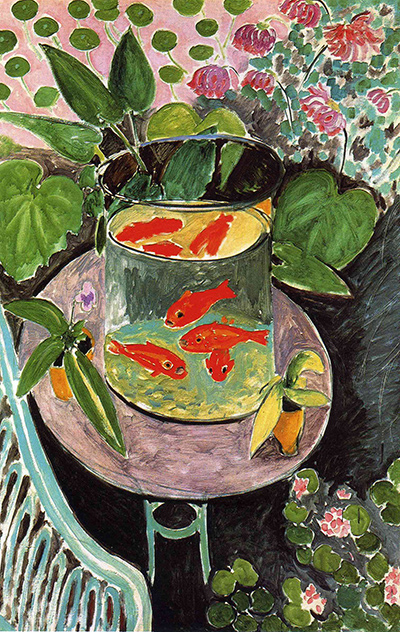Matisse painted Goldfish at home in Issy-les-Moulineaux, near Paris.
This oil on canvas painting belongs to a series that Matisse produced between spring and early summer 1912.
Completed seven years after Matisse’s famous 1905 exhibition, this painting retains some of the vibrant colour and solid linear patterns associated with Fauves. However, it is a more subtle representation than other earlier works, combining colours and shapes in symphonic unity.
Beckoning the viewer towards the scene, the bright orange fish are central to the canvas against a colourful backdrop. The foliage as well as the ornamental railing or bench rail mimic the curves in the table on which the goldfish bowl perches. The entire composition feels balanced and the use of colours exudes a sense of soothing calm.
Goldfish became a recurring theme for Matisse. Appearing in nine of his paintings, as well as in his sketches and printworks. The goldfish immediately attract attention due to their colour. The vibrant orange strongly contrasts with the more subdued pinks and greens that surround the fish bowl and the sea green background. As complementary colours, when placed next to each other, blue and orange, as well as green and red, really set each other off.
Used extensively by the Fauves, this technique is particularly striking in Matisse’s earlier canvas Le Bonheur de Vivre. Although he later softened his palette, the bold orange is reminiscent of Matisse’s fauvist years, which continued to influence his use of colour until he died.
Matisse was perhaps interested in goldfish following a recent trip to Tangier, Morocco where he observed locals daydreaming whilst peering into goldfish bowls. He admired the Moroccans’ relaxed, contemplative lifestyle. For Matisse, the goldfish came to symbolise this serene state of mind. It also became a symbol of a paradise lost, a subject frequently represented in art.
This painting is an illustration of some of the major themes in Matisse’s painting: his use of complementary colours, his search for an idyllic paradise, his quest for contemplative relaxation for the observer and his complex construction of pictorial space.




